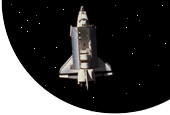"NASA split over space station noise"
Incident hints at culture clash that shuttle probe didn’t fix
http://www.msnbc.com/news/1000491.asp
COMMENTARY
By James Oberg
NBC NEWS SPACE ANALYST
MSNBC.com (Oberg):
HOUSTON, Dec. 2 — The loud crunch that startled the crew of the international space station last week is still echoing through the halls of Mission Control in Houston. And it seems to have sparked a culture clash between those who have learned the lessons of the Columbia catastrophe, and those who apparently haven’t.
SOME OFFICIALS and spokesmen quickly decided that since no harm seemed to have been done, there was nothing to worry about — even if the cause remained unknown. Opposing them were engineers who realized that simply because the cause of the noise was still unsolved, it was something to worry about. The latter group well remembers how the unproven assumption of “no hazard” had aborted any possibility of recognizing the fatal wound to the shuttle last January and doomed its crew, despite the countermeasures that in hindsight an alerted NASA might have developed.
MSNBC.com has learned that this time, unlike last January, concerned engineers successfully argued to ask for outside help. According to Keith Cowing of the independent NASA Watch Web site, military optical sensors are being trained on the station to see if there’s any visible damage in the area the sound came from. Possible damage could be from a collision, from an internal rupture or from mechanical fatigue on the skin; many theories have been suggested.
One of the results of the Columbia disaster was a formal agreement, or memo of understanding, between NASA and the Pentagon on exactly how to request such “tasking” of military assets, and according to Cowing just such a process is now under way. However, when asked directly, officials at NASA’s Johnson Space Center in Houston told MSNBC.com they were unable to confirm this.
Reports of the detailed examination come amid official pronouncements in Houston and Moscow that a survey with an external camera showed there’s nothing to worry about.
“Subsequent inspections showed there was no collision whatsoever,” a Russian spokesman told Reuters, referring to the video survey.
“There is not a lot left to analyze — everything is working fine on board,” NASA spokesman James Hartsfield said. “Our best camera surveys showed nothing out of the ordinary.”
NASA’s official weekly status report made the same assertion: “Exterior television cameras on the robotic arm and the station truss were used to inspect the exterior, and nothing unusual was identified.”
‘ILLOGICAL CONCLUSIONS’
Insiders did not agree. “Don’t believe everything you read in the papers,” a senior Mission Control official said in a private e-mail. “We are looking at it very carefully.” They pointed out that the cameras used in the initial survey had only very shallow views of part of the suspected area, and could not see other surface areas at all.
Charles Harlan, former head of the safety office at Johnson Space Center, said he agreed that the initial “all is well” assertions were “illogical conclusions,” and he was surprised NASA had officially taken that view.
“The noise is telling them something,” he told MSNBC.com. “It may or may not be a serious or near-term problem.”
The noise was heard Nov. 26 at 2:59 a.m. ET (7:59 a.m. GMT, the time zone used by the crew). In the Russian-built service module, where the main life support and dining equipment is located, cosmonaut Alexander Kaleri was about to draw himself his morning tea, and astronaut Michael Foale had opened his laptop to read his overnight e-mail.
Suddenly, above the already-loud din of fans, regulators, motors, electrical circuits and other noisy equipment, both men heard a drawn-out metallic crunch, apparently coming from the outside. Foale later likened it to a metal can being crushed and then unfolded, or like the “whumping sound” made by shaking a large thin sheet of metal. It was unlike anything either man had ever heard before, and together they had almost two years of flight experience on the space shuttle, the international space station and the now-defunct Russian Mir space station.
Foale elaborated on his and Kaleri’s reactions during an interview with journalists Monday. The two men hurried to check their air pressure, instinctively realizing that an impact and hull puncture was the most immediately damaging possibility. Foale had been aboard Mir in mid-1997 when a collision with a cargo drone broke a hole in the hull of one of the modules.
Kaleri tapped a mechanical pressure gauge with his fingers, and told Foale the pressure was dropping. But Foale recalled doubting the report. “I know that I can feel in my ears a fast pressure drop,” he explained, and none was evident. He checked the station instrumentation readings, and a pressure gauge on his wristwatch, and verified that pressure was stable.
There were no records of a thruster rocket firing, and pressures in all tanks looked solid. Some strange hiccups on the main stabilizing gyroscopes were puzzling, but didn’t seem too far off nominal to provide any useful insight — at least at first.
“I don’t think it was anything,” Foale told Mission Control a few days after the incident. “It was a sound, but nothing happened after that. I think everything is OK.”
Foale’s comment was reminiscent of his bold talk before reaching Mir in 1997 (“I’m not worried about it — the safety is perfectly assured”).
At Mission Control, space workers were not lulled. Almost a week after the event, a NASA spokesman privately described how engineers “are still scratching their heads” over this event. No single leading theory has yet emerged, he said.
OTHER POSSIBILITIES
The Russians think it could have been an air fan choking on some dislodged object in the ventilation shaft — but no fragments were found, nor any damage to the fan noticed. Other engineers suspect one of the gearboxes for the module’s rotating solar panels may have had a temporary “hang” and then jerked free. The shudder could also be a sign of some stressed structural component suddenly releasing.
Or it really could have been an impact with a small piece of space junk. Objects larger than about 4 inches (10 centimeters) can be tracked on radar, and objects smaller than a half-inch (1 centimeter) can be stopped harmlessly by shields installed during a spacewalk last year. But junk between 1 and 10 centimeters in size could hit undetected and do damage — though not very often, space safety statisticians believe.
The station’s original design called for full external visibility to survey cameras. A special Russian module called the Science Power Platform was supposed to have been installed alongside the oldest element of the space station, the Zarya cargo module, and the European Space Agency had built a special robot arm with a TV camera for operation there. But Russia canceled the special module for budget reasons, and the European robot arm remains in storage in a warehouse.
If the new images show something suspicious — and it may be difficult to show them to the Russians without compromising U.S. national security about how sharp spy satellite cameras really are — then closer views can be sought. A scheduled spacewalk in February could be moved up, or the astronauts could get into their Soyuz spacecraft and fly it over to the suspect area.
Meanwhile, NASA engineers continue their investigation. Some of them, at least, seem to have taken to heart the recommendations of the Columbia Accident Investigation Board that “ignorance is not bliss.” If something unusual happens in space, you can’t assume it’s safe until a hazard is proven; you must assume it is hazardous until its safety can be proven. This is a lesson that people in extreme environments back on Earth have always known, but which NASA seemed to have forgotten.
“I was stationed on a nuclear submarine for three years, and during that time, [a noise] was the main method of knowing about an equipment casualty,” space historian Tom Merkle noted in an Internet discussion. “Living in a tube for several months, you get very used to ‘normal’ noises, and a different one occurring — different and loud enough to notice — is usually a bad sign. The bigger the noise, the bigger the problem.”
James Oberg, space analyst for NBC News, spent 22 years at the Johnson Space Center as a Mission Control operator and an orbital designer. |

